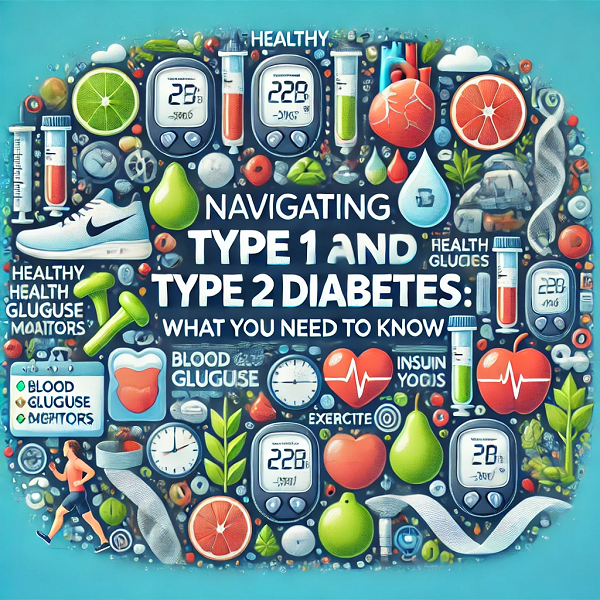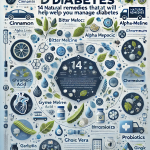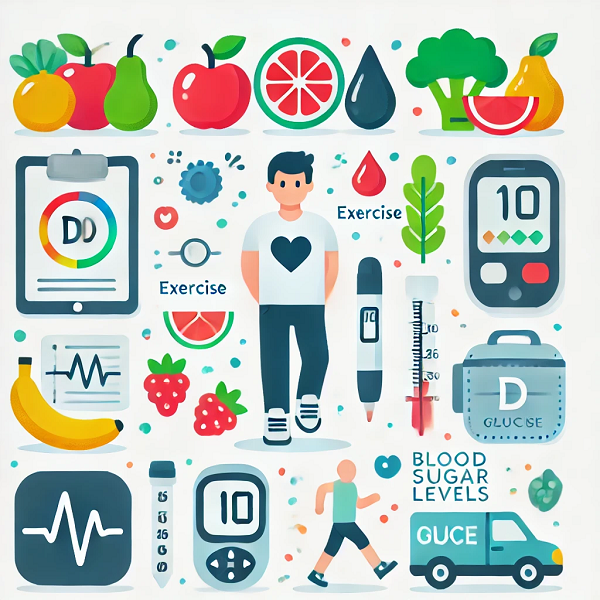Diabetes is a chronic condition affecting millions worldwide, characterized by high blood glucose levels due to insulin issues. It is broadly classified into Type 1 and Type 2 diabetes, each with distinct causes, symptoms, and management strategies. Understanding the differences between these two types is crucial for effective treatment and management.
What is Type 1 Diabetes?
Type 1 Diabetes: An Autoimmune Condition
Type 1 diabetes is a chronic autoimmune condition in which the body’s immune system, designed to defend against infections and diseases, mistakenly targets and destroys the insulin-producing beta cells located in the pancreas. Insulin is a crucial hormone that regulates blood sugar levels by facilitating the entry of glucose into the cells for energy. When these beta cells are destroyed, the pancreas produces little to no insulin, leading to elevated blood glucose levels. This lack of insulin production requires those affected to depend on external sources of insulin to manage their blood sugar levels.
Manifestation and Onset
Type 1 diabetes typically manifests in childhood or adolescence, earning it the former name “juvenile diabetes.” However, it can develop at any age, including in adults. Early diagnosis and treatment are critical to managing the condition and preventing complications. Unlike Type 2 diabetes, which is often related to lifestyle factors and develops over time, Type 1 diabetes usually has a rapid onset, with symptoms appearing suddenly and progressing quickly.
Causes of Type 1 Diabetes
The exact cause of Type 1 diabetes remains unknown, but it is understood to involve a combination of genetic and environmental factors:
- Genetic Factors: Certain genetic markers are associated with an increased risk of developing Type 1 diabetes. If a close family member, such as a parent or sibling, has Type 1 diabetes, the risk is higher, though the majority of people with Type 1 diabetes do not have a family history of the condition.
- Environmental Triggers: Researchers believe that environmental factors, such as viral infections, may trigger the autoimmune response in genetically predisposed individuals. Specific viruses are thought to provoke the immune system to mistakenly attack the pancreas’s beta cells.
Symptoms of Type 1 Diabetes
The symptoms of Type 1 diabetes can appear suddenly and include the following:
- Frequent Urination: High blood sugar levels cause the kidneys to remove excess glucose from the blood, leading to increased urination.
- Extreme Thirst: As the body loses more water through frequent urination, it can lead to dehydration and a persistent feeling of thirst.
- Unexplained Weight Loss: Without insulin, the body cannot use glucose for energy and begins to break down fat and muscle tissue instead, leading to weight loss despite normal or increased food intake.
- Fatigue: The lack of glucose in the cells results in a constant feeling of tiredness and lack of energy.
- Blurred Vision: High blood sugar levels can cause swelling in the lens of the eye, leading to blurred vision.
- Increased Hunger: As the body cannot utilize glucose effectively, it may cause an increase in hunger as it seeks more energy sources.
Management of Type 1 Diabetes
Managing Type 1 diabetes is a lifelong commitment that involves several key strategies to maintain blood sugar levels within a healthy range and prevent complications:
- Insulin Therapy: Individuals with Type 1 diabetes must take insulin to replace the hormone their bodies no longer produce. Insulin can be administered through multiple daily injections using a syringe or insulin pen, or via an insulin pump, a device that delivers a continuous supply of insulin through a small tube inserted under the skin. The type and dosage of insulin are tailored to each individual’s needs, and it may require adjustments based on factors like diet, activity levels, and blood sugar readings.
- Blood Sugar Monitoring: Regular monitoring of blood sugar levels is essential for managing Type 1 diabetes. Patients use a blood glucose meter or continuous glucose monitor (CGM) to check their levels multiple times a day. This information helps them adjust their insulin dosage, food intake, and physical activity to maintain stable blood glucose levels.
- Balanced Diet: A healthy, balanced diet plays a crucial role in managing Type 1 diabetes. It is essential to understand how different foods, especially carbohydrates, affect blood sugar levels. Patients often work with a dietitian to create a meal plan that includes a variety of nutrients and helps keep blood sugar levels stable. Carbohydrate counting and understanding the glycemic index of foods can be helpful tools in this process.
- Physical Activity: Regular exercise is important for overall health and can help improve insulin sensitivity, allowing the body to use insulin more effectively. However, it requires careful planning and monitoring of blood sugar levels to avoid hypoglycemia (low blood sugar).
- Education and Support: Continuous education about diabetes management is crucial. Patients, along with their families, need to understand the disease, treatment options, and lifestyle adjustments. Support groups and counseling can also provide emotional support and practical advice.
- Regular Medical Check-ups: Regular visits to healthcare professionals, including endocrinologists, dietitians, and diabetes educators, are vital to managing the condition effectively. These professionals can help monitor progress, adjust treatment plans, and provide ongoing education.
Type 1 diabetes is a serious but manageable condition. With the right combination of insulin therapy, blood sugar monitoring, a balanced diet, physical activity, and continuous education, individuals with Type 1 diabetes can lead healthy, active lives. Early diagnosis and effective management are key to preventing complications and maintaining a good quality of life.
What is Type 2 Diabetes?
Type 2 Diabetes: A Metabolic Disorder
Type 2 diabetes is a chronic metabolic disorder characterized by the body’s inability to effectively use insulin, a hormone produced by the pancreas that regulates blood sugar levels. This condition can arise from two primary issues: insulin resistance, where the body’s cells do not respond properly to insulin, and insufficient insulin production by the pancreas. As a result, glucose accumulates in the bloodstream, leading to elevated blood sugar levels. Unlike Type 1 diabetes, which is an autoimmune condition, Type 2 diabetes is primarily related to lifestyle factors and genetic predispositions.
Increasing Prevalence
While Type 2 diabetes is more commonly diagnosed in adults, it is becoming increasingly prevalent in younger populations, including adolescents and children. This rise is largely attributed to the global increase in obesity rates and sedentary lifestyles. Early detection and intervention are crucial to prevent the long-term complications associated with Type 2 diabetes.
Causes and Risk Factors
The development of Type 2 diabetes is influenced by a combination of genetic and environmental factors. Key risk factors include:
- Genetics: A family history of Type 2 diabetes significantly increases an individual’s risk. Specific genetic markers and variations can predispose individuals to develop insulin resistance or impaired insulin production.
- Obesity: Excess body fat, particularly around the abdomen, is a major risk factor for Type 2 diabetes. Fat cells release substances that can lead to insulin resistance, making it harder for the body to use insulin effectively.
- Physical Inactivity: A sedentary lifestyle contributes to weight gain and increases the risk of insulin resistance. Regular physical activity helps maintain a healthy weight and improves the body’s ability to use insulin.
- Poor Diet: Diets high in processed foods, sugary beverages, and unhealthy fats contribute to obesity and insulin resistance. Conversely, a diet rich in whole grains, fruits, vegetables, and lean proteins can help manage blood sugar levels.
- Age: The risk of developing Type 2 diabetes increases with age, particularly after the age of 45. However, with rising obesity rates, more young people are being diagnosed with the condition.
- Ethnicity: Certain ethnic groups, including African Americans, Hispanics, Native Americans, and Asian Americans, have a higher risk of developing Type 2 diabetes.
- Other Health Conditions: Conditions such as hypertension, high cholesterol, and polycystic ovary syndrome (PCOS) are associated with an increased risk of Type 2 diabetes.
Symptoms of Type 2 Diabetes
The symptoms of Type 2 diabetes often develop gradually and can be subtle, making early detection challenging. Common symptoms include:
- Increased Thirst: Elevated blood sugar levels can cause dehydration, leading to a persistent feeling of thirst.
- Frequent Urination: The kidneys work harder to filter and absorb the excess glucose, resulting in increased urination.
- Increased Hunger: Despite high blood sugar levels, the body’s cells are deprived of glucose, triggering increased hunger as the body seeks more energy.
- Fatigue: The lack of effective glucose utilization by the cells results in constant tiredness and lack of energy.
- Blurred Vision: High blood sugar levels can cause fluid to be pulled from the lenses of the eyes, leading to blurred vision.
- Slow-Healing Sores or Frequent Infections: High blood sugar levels can impair the immune system, making it harder for the body to heal wounds and fight off infections.
- Tingling or Numbness in Hands or Feet: Prolonged high blood sugar levels can cause nerve damage, leading to symptoms like tingling, numbness, or pain in the extremities.
Management of Type 2 Diabetes
Managing Type 2 diabetes involves a comprehensive approach that focuses on lifestyle changes, medication, and regular monitoring of blood sugar levels. Key management strategies include:
- Lifestyle Changes
- Healthy Diet: Adopting a balanced diet is crucial for managing blood sugar levels. Emphasis should be placed on whole grains, fruits, vegetables, lean proteins, and healthy fats. Carbohydrate counting and understanding the glycemic index of foods can help individuals make informed dietary choices.
- Regular Exercise: Physical activity helps improve insulin sensitivity and aids in weight management. A combination of aerobic exercises, such as walking or swimming, and strength training is recommended.
- Weight Management: Achieving and maintaining a healthy weight can significantly improve blood sugar control and reduce the risk of complications. Weight loss, even in small amounts, can have a positive impact on blood sugar levels.
- Medications
- Oral Medications: Various oral medications are available to help manage Type 2 diabetes. These medications work in different ways, such as improving insulin sensitivity, increasing insulin production, or decreasing glucose production by the liver. Common medications include metformin, sulfonylureas, and DPP-4 inhibitors.
- Injectable Medications: In some cases, injectable medications such as GLP-1 receptor agonists or insulin may be required. These medications help regulate blood sugar levels and can be used in combination with oral medications.
- Blood Sugar Monitoring
- Regular monitoring of blood sugar levels is essential for effective diabetes management. This helps individuals understand how their diet, exercise, and medications affect their blood sugar levels and allows for timely adjustments to their treatment plan.
- Education and Support
- Continuous education about diabetes management is crucial. Patients should work closely with healthcare professionals, including endocrinologists, dietitians, and diabetes educators, to stay informed about their condition and treatment options. Support groups and counseling can provide emotional support and practical advice for managing diabetes.
- Regular Medical Check-ups
- Regular visits to healthcare professionals are vital for monitoring the progression of diabetes and preventing complications. These check-ups typically include monitoring blood pressure, cholesterol levels, kidney function, and eye health.
Type 2 diabetes is a complex condition that requires a multifaceted approach to management. By understanding the risk factors, recognizing the symptoms, and adopting a proactive approach to lifestyle changes and medication, individuals with Type 2 diabetes can lead healthy and fulfilling lives. Early detection and effective management are key to preventing complications and maintaining a good quality of life.
Key Differences Between Type 1 and Type 2 Diabetes
Understanding the key differences between Type 1 and Type 2 diabetes is crucial for effective diagnosis, treatment, and management. Here are the primary distinctions:
Age of Onset
Type 1 Diabetes: Type 1 diabetes often begins in childhood or adolescence, which is why it was previously referred to as juvenile diabetes. However, it can develop at any age. The onset is usually abrupt, with symptoms appearing suddenly over a few weeks or months. Early signs in children and adolescents may include extreme thirst, frequent urination, unintended weight loss, and fatigue.
Type 2 Diabetes: Type 2 diabetes typically occurs in adults, especially those over the age of 45. However, due to rising obesity rates and sedentary lifestyles, it is increasingly being diagnosed in younger individuals, including children and teenagers. The onset of Type 2 diabetes is usually gradual, and symptoms can develop over several years, often going unnoticed until a routine medical check-up or the occurrence of complications.
Insulin Dependence
Type 1 Diabetes: People with Type 1 diabetes require insulin therapy for survival. Their bodies do not produce insulin due to the autoimmune destruction of the pancreatic beta cells. Insulin must be administered through injections or an insulin pump to regulate blood sugar levels and prevent life-threatening complications such as diabetic ketoacidosis (DKA). This lifelong dependency on insulin distinguishes Type 1 diabetes from Type 2.
Type 2 Diabetes: Individuals with Type 2 diabetes may not initially require insulin therapy. Their condition can often be managed with lifestyle changes, such as adopting a healthy diet, increasing physical activity, and maintaining a healthy weight. Oral medications and non-insulin injectables can also help control blood sugar levels. However, as the disease progresses, some people with Type 2 diabetes may need insulin therapy to achieve adequate blood sugar control.
Causes
Type 1 Diabetes: Type 1 diabetes is an autoimmune disease. The body’s immune system mistakenly attacks and destroys the insulin-producing beta cells in the pancreas. The exact cause of this autoimmune response is unknown, but it is believed to involve a combination of genetic susceptibility and environmental triggers, such as viral infections. Family history and certain genetic markers increase the risk of developing Type 1 diabetes, although the majority of cases occur without a known family history.
Type 2 Diabetes: Type 2 diabetes is primarily linked to lifestyle factors and insulin resistance. The body’s cells become resistant to the effects of insulin, and the pancreas cannot produce enough insulin to overcome this resistance. Risk factors for Type 2 diabetes include obesity, physical inactivity, poor diet, age, and a family history of diabetes. Unlike Type 1, Type 2 diabetes is often preventable through healthy lifestyle choices.
Prevalence
Type 1 Diabetes: Type 1 diabetes is less common, accounting for approximately 5-10% of all diabetes cases. It affects about 1.6 million Americans, including approximately 200,000 youth under the age of 20. Although it is less prevalent, Type 1 diabetes requires intensive management and lifelong insulin therapy.
Type 2 Diabetes: Type 2 diabetes is far more common, making up about 90-95% of all diabetes cases. It affects over 30 million Americans and is a growing public health concern worldwide. The high prevalence of Type 2 diabetes is associated with the increasing rates of obesity, physical inactivity, and unhealthy dietary habits. Early detection and intervention are crucial to managing the condition and preventing complications.
Progression
Type 1 Diabetes: The progression of Type 1 diabetes is typically rapid. Symptoms develop quickly, often over a few weeks, and can become severe if not treated promptly. The sudden onset of symptoms, such as excessive thirst, frequent urination, weight loss, and fatigue, usually leads to a swift diagnosis. Without insulin therapy, Type 1 diabetes can result in life-threatening complications, including diabetic ketoacidosis (DKA).
Type 2 Diabetes: The progression of Type 2 diabetes is generally slow and gradual. Symptoms can develop over several years and may be mild or go unnoticed. Common symptoms, such as increased thirst, frequent urination, and fatigue, often appear after prolonged periods of insulin resistance and elevated blood sugar levels. Because of the gradual onset, many people with Type 2 diabetes are diagnosed only after complications have developed. Regular screening and early detection are essential to manage and slow the progression of the disease.
While both Type 1 and Type 2 diabetes involve issues with insulin and blood sugar regulation, they differ significantly in terms of age of onset, causes, insulin dependence, prevalence, and progression. Understanding these differences is vital for effective diagnosis, treatment, and management of each type. Early intervention, appropriate treatment, and lifestyle modifications can help individuals with diabetes lead healthy and fulfilling lives.
Diagnosis and Testing
Diagnosing diabetes accurately is crucial for effective management and treatment. Several tests are commonly used to diagnose diabetes, each providing valuable information about blood sugar levels and how the body processes glucose. Here’s a detailed look at these essential diagnostic tests:
Fasting Blood Sugar Test
Fasting Blood Sugar Test: This test measures the blood sugar level after an individual has fasted for at least eight hours, typically overnight. It is a straightforward and commonly used test to assess how the body manages blood sugar levels in a fasting state.
- Procedure: The individual is required to fast (no food or drink except water) for at least 8 hours before the test. Blood is then drawn from a vein and analyzed in a laboratory.
- Normal Range: A fasting blood sugar level below 100 mg/dL (5.6 mmol/L) is considered normal.
- Prediabetes Range: A fasting blood sugar level between 100 and 125 mg/dL (5.6 to 6.9 mmol/L) indicates prediabetes, a condition where blood sugar levels are higher than normal but not yet high enough to be classified as diabetes.
- Diabetes Range: A fasting blood sugar level of 126 mg/dL (7.0 mmol/L) or higher on two separate occasions confirms a diagnosis of diabetes.
Oral Glucose Tolerance Test (OGTT)
Oral Glucose Tolerance Test (OGTT): This test evaluates the body’s ability to process glucose by measuring blood sugar levels before and after consuming a glucose-rich beverage. It is particularly useful for diagnosing gestational diabetes and for detecting diabetes in individuals with borderline fasting blood sugar levels.
- Procedure: The test begins with a fasting blood sugar test. After the initial blood draw, the individual consumes a sugary drink containing a specific amount of glucose (usually 75 grams). Blood samples are then taken at regular intervals (typically at 1 hour and 2 hours) to measure how the body processes the glucose.
- Normal Range: A blood sugar level less than 140 mg/dL (7.8 mmol/L) two hours after drinking the glucose solution is considered normal.
- Prediabetes Range: A blood sugar level between 140 and 199 mg/dL (7.8 to 11.0 mmol/L) two hours after drinking the glucose solution indicates prediabetes.
- Diabetes Range: A blood sugar level of 200 mg/dL (11.1 mmol/L) or higher two hours after drinking the glucose solution confirms a diagnosis of diabetes.
Hemoglobin A1c Test
Hemoglobin A1c Test: Also known as the glycated hemoglobin test or HbA1c test, this test provides an average blood sugar level over the past two to three months. It measures the percentage of hemoglobin (a protein in red blood cells) that is coated with sugar (glycated).
- Procedure: A blood sample is drawn and analyzed in a laboratory. The test can be performed at any time of the day and does not require fasting.
- Normal Range: An HbA1c level below 5.7% is considered normal.
- Prediabetes Range: An HbA1c level between 5.7% and 6.4% indicates prediabetes.
- Diabetes Range: An HbA1c level of 6.5% or higher on two separate tests confirms a diagnosis of diabetes.
Additional Diagnostic Tests
In addition to the primary tests mentioned above, healthcare providers may use other tests and assessments to diagnose diabetes and monitor its progression:
- Random Blood Sugar Test: This test measures blood sugar levels at any time of the day, regardless of when the individual last ate. A random blood sugar level of 200 mg/dL (11.1 mmol/L) or higher, along with symptoms of diabetes (such as increased thirst and frequent urination), can indicate diabetes.
- C-Peptide Test: This test measures the level of C-peptide, a substance produced in equal amounts to insulin. It helps differentiate between Type 1 and Type 2 diabetes by indicating how much insulin the pancreas is producing.
- Autoantibody Tests: For suspected Type 1 diabetes, tests that detect specific autoantibodies (such as GAD antibodies) can confirm the autoimmune nature of the disease.
- Urine Tests: While not used for diagnosis, urine tests can detect the presence of ketones (byproducts of fat breakdown), which can indicate diabetic ketoacidosis, a serious complication of diabetes.
Accurate diagnosis of diabetes is critical for effective treatment and management. The fasting blood sugar test, oral glucose tolerance test, and hemoglobin A1c test are essential tools in diagnosing diabetes and assessing its severity. Early detection through these tests allows for timely intervention, helping individuals manage their condition and prevent complications. If you suspect you may have diabetes or are at risk, consult a healthcare provider for proper testing and diagnosis.
Long-term Complications of Diabetes
Both Type 1 and Type 2 diabetes can lead to severe long-term complications if not managed properly. Consistently high blood sugar levels can damage various organs and systems in the body, leading to a range of serious health issues. Here are some of the most common long-term complications associated with diabetes:
Cardiovascular Disease
Cardiovascular Disease: Individuals with diabetes have a significantly increased risk of developing cardiovascular diseases, including coronary artery disease, heart attack, stroke, and hypertension (high blood pressure).
- Heart Disease: High blood sugar levels can damage the blood vessels and nerves that control the heart, leading to coronary artery disease. This can cause chest pain (angina), heart attack, and even heart failure.
- Stroke: Diabetes increases the risk of stroke by contributing to the buildup of fatty deposits in the arteries, known as atherosclerosis. This can block blood flow to the brain, leading to a stroke.
- Hypertension: High blood pressure is common in people with diabetes and can further increase the risk of cardiovascular complications.
Neuropathy
Neuropathy: Diabetic neuropathy refers to nerve damage caused by prolonged high blood sugar levels. This condition can affect various parts of the body and cause a range of symptoms.
- Peripheral Neuropathy: This is the most common form of diabetic neuropathy, affecting the nerves in the hands, feet, legs, and arms. Symptoms include pain, tingling, burning sensations, and numbness. Severe cases can lead to muscle weakness and loss of reflexes.
- Autonomic Neuropathy: This type affects the autonomic nervous system, which controls involuntary functions such as digestion, heart rate, and bladder function. Symptoms can include gastrointestinal issues (constipation or diarrhea), urinary problems, sexual dysfunction, and abnormal heart rates.
Nephropathy
Nephropathy: Diabetic nephropathy is a type of kidney damage that occurs due to long-term high blood sugar levels. It is a leading cause of kidney failure and end-stage renal disease (ESRD).
- Kidney Damage: High blood sugar levels can damage the blood vessels in the kidneys, impairing their ability to filter waste from the blood effectively. Early signs of nephropathy include protein in the urine (proteinuria) and elevated blood pressure.
- Kidney Failure: If not managed properly, nephropathy can progress to kidney failure, requiring dialysis or kidney transplantation. Regular monitoring of kidney function is crucial for people with diabetes to detect and manage nephropathy early.
Retinopathy
Retinopathy: Diabetic retinopathy is a condition in which high blood sugar levels damage the blood vessels in the retina, the light-sensitive tissue at the back of the eye. It is a leading cause of blindness in adults.
- Non-proliferative Retinopathy: In the early stages, the blood vessels in the retina may leak fluid or blood, causing the retina to swell. This can lead to blurry vision and, if left untreated, progress to more severe stages.
- Proliferative Retinopathy: In advanced stages, new, abnormal blood vessels may grow on the surface of the retina. These vessels can bleed into the vitreous (the clear gel-like substance inside the eye), causing vision loss and potentially leading to retinal detachment.
- Macular Edema: Swelling in the macula (the central part of the retina) can also occur, further impairing vision. Regular eye exams are essential for early detection and treatment of retinopathy.
Foot Problems
Foot Problems: Diabetes can lead to various foot problems due to poor circulation and nerve damage (peripheral neuropathy). These issues can result in severe complications if not addressed promptly.
- Poor Circulation: High blood sugar levels can cause poor blood flow to the extremities, particularly the feet. This can result in slow-healing wounds and a higher risk of infections.
- Neuropathy: Nerve damage in the feet can cause loss of sensation, making it difficult to detect injuries, blisters, or ulcers. Without proper sensation, minor foot injuries can go unnoticed and become infected.
- Foot Ulcers: Open sores or ulcers can develop on the feet due to poor circulation and neuropathy. These ulcers can become severely infected and may not heal properly.
- Amputations: In severe cases, infections can spread to the bone and other tissues, necessitating amputation of the affected limb. Diabetes is a leading cause of non-traumatic lower limb amputations worldwide.
Managing diabetes effectively is crucial to preventing these long-term complications. This includes maintaining healthy blood sugar levels through a balanced diet, regular physical activity, medication adherence, and routine medical check-ups. Early detection and intervention are key to managing and mitigating the impact of these complications. Individuals with diabetes should work closely with their healthcare providers to develop a comprehensive management plan tailored to their needs, reducing the risk of severe health issues and improving their overall quality of life.
Living with Diabetes
Living with diabetes requires a comprehensive and holistic approach to manage the condition effectively and prevent complications. This approach encompasses various aspects of daily life, including diet, exercise, monitoring, medication, and education. Here’s a detailed guide to living well with diabetes:
Diet
Diet: A balanced diet is fundamental in managing diabetes. Eating the right foods in the right amounts can help maintain stable blood glucose levels and promote overall health.
- Nutrient-Rich Foods: A diet rich in vegetables, lean proteins, and whole grains is beneficial. Vegetables provide essential vitamins, minerals, and fiber while being low in calories and carbohydrates. Lean proteins, such as chicken, fish, tofu, and legumes, help maintain muscle mass and support metabolic functions. Whole grains, like brown rice, quinoa, and oats, have a lower glycemic index than refined grains, helping to stabilize blood sugar levels.
- Carbohydrate Counting: Understanding how carbohydrates affect blood sugar is crucial. Carbohydrates are the main source of glucose in the diet, and counting carbohydrates can help manage blood sugar levels more effectively. This involves measuring and keeping track of the amount of carbs consumed at each meal.
- Portion Control: Eating smaller, more frequent meals can help avoid blood sugar spikes and dips. Portion control is also essential to avoid overeating and maintain a healthy weight.
- Healthy Fats: Incorporating healthy fats, such as those found in avocados, nuts, seeds, and olive oil, can improve heart health and help with satiety without negatively impacting blood sugar levels.
Exercise
Exercise: Regular physical activity is a cornerstone of diabetes management. It helps improve insulin sensitivity, lowers blood sugar levels, and enhances overall well-being.
- Types of Exercise: Both aerobic exercises (such as walking, running, swimming, and cycling) and resistance training (such as weight lifting and body-weight exercises) are beneficial. A combination of these types of exercise provides the best results for managing diabetes.
- Consistency: Aim for at least 150 minutes of moderate-intensity aerobic activity per week, combined with two to three days of resistance training. Consistency is key, so finding enjoyable activities can help make exercise a regular part of the routine.
- Monitoring: Before, during, and after exercise, monitoring blood sugar levels is important to understand how physical activity affects them. It’s also essential to carry fast-acting carbohydrates (like glucose tablets) in case of hypoglycemia (low blood sugar) during exercise.
Monitoring
Monitoring: Regular blood glucose monitoring is essential for managing diabetes effectively. It helps track how lifestyle choices and medications affect blood sugar levels and enables timely adjustments to the management plan.
- Blood Glucose Meters: These portable devices allow individuals to check their blood sugar levels at home. Regular monitoring helps identify patterns and manage blood sugar levels more effectively.
- Continuous Glucose Monitors (CGMs): These devices provide real-time blood sugar readings throughout the day and night. CGMs can alert users to highs and lows, helping to prevent dangerous blood sugar swings.
- HbA1c Test: This test measures the average blood sugar levels over the past two to three months. It is usually performed by a healthcare provider every three to six months to assess overall blood sugar control.
Medication
Medication: Following prescribed medication regimens is crucial for controlling blood sugar levels and preventing complications.
- Insulin Therapy: Individuals with Type 1 diabetes and some with Type 2 diabetes require insulin to regulate blood sugar levels. Insulin can be administered through injections or an insulin pump.
- Oral Medications: Many people with Type 2 diabetes manage their condition with oral medications that help lower blood sugar levels. These medications work in various ways, such as improving insulin sensitivity, stimulating insulin production, or reducing glucose production by the liver.
- Non-Insulin Injectables: Some medications, like GLP-1 receptor agonists, are injected and help control blood sugar levels by enhancing insulin secretion, slowing gastric emptying, and reducing appetite.
Education
Education: Ongoing education about diabetes management is essential for patients and their families. Understanding the condition, treatment options, and lifestyle adjustments empowers individuals to take control of their health.
- Diabetes Education Programs: These programs provide comprehensive information on managing diabetes, including diet, exercise, medication, and monitoring. They also offer support for dealing with the emotional aspects of living with a chronic condition.
- Support Groups: Connecting with others who have diabetes can provide emotional support, practical advice, and motivation. Support groups, both in-person and online, can be valuable resources.
- Healthcare Team: Regular consultations with a healthcare team, including endocrinologists, dietitians, diabetes educators, and mental health professionals, can help individuals manage their diabetes effectively.
Understanding the Differences
Understanding the Differences: Understanding the differences between Type 1 and Type 2 diabetes is essential for effective management and prevention of complications.
- Type 1 Diabetes: Requires lifelong insulin therapy, and management focuses on maintaining stable blood sugar levels through careful monitoring and lifestyle adjustments.
- Type 2 Diabetes: May be managed with lifestyle changes, oral medications, and sometimes insulin. Emphasis is on weight management, healthy eating, and regular physical activity to improve insulin sensitivity and lower blood sugar levels.
Advancements in Treatment and Technology
Advancements in treatment and technology continue to improve the quality of life for those affected by diabetes.
- Insulin Pumps and CGMs: These devices provide more precise insulin delivery and continuous blood sugar monitoring, reducing the risk of hypoglycemia and hyperglycemia.
- Artificial Pancreas Systems: These systems combine an insulin pump and CGM to automatically adjust insulin delivery based on real-time blood sugar levels, providing better glucose control.
- New Medications: Research continues to develop new medications that offer better blood sugar control, fewer side effects, and improved convenience.
Conclusion
Living with diabetes involves a holistic approach that includes a balanced diet, regular exercise, consistent blood glucose monitoring, adherence to medication regimens, and ongoing education. Understanding the differences between Type 1 and Type 2 diabetes is essential for effective management and prevention of complications. With advancements in treatment and technology, individuals with diabetes can lead healthy and fulfilling lives, empowered to take control of their condition.
References
- American Diabetes Association
- Mayo Clinic – Diabetes
- National Institute of Diabetes and Digestive and Kidney Diseases
#diabetes #type1diabetes #type2diabetes #insulin #bloodsugar #diabetesawareness #diabetesmanagement #healthyliving #diabetessupport #chronicillness







